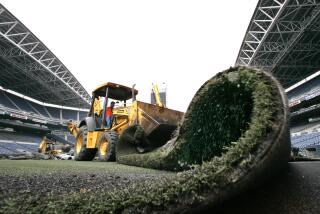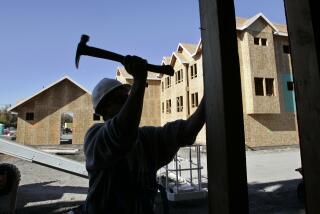A Healthy Future Is Projected for Eco-Friendly Homes
Studio City architect Dennis Bottum is hoping that a growing environmental awareness will translate into a successful foray for him in the home building business. Bottum is in the middle of getting city approval for the first of several ecologically correct homes he wants to build just north of Mulholland Drive in the Hollywood Hills.
Bottum and his firm, DBA DePaul Architecture, are planning a traditional-looking Southwest home of about 3,600 square feet. This $1.3-million house, however, will feature nontoxic paints and adhesives, tiles made out of recycled windshield glass, reused redwood and a photovoltaic array to convert sunlight into electricity.
“There’s a growing concern amongst home buyers about toxics in their homes and the environment,” Bottum observed. “Up until now, though, eco-homes have mostly been the subject of talk.” Turning this talk into action, he conceded, “is a risky proposition.”
An increasing number of builders and remodelers are starting to think about how to build more eco-friendly homes. “We started becoming more aware a couple of years ago,” said Mary Altmann, owner of Altmann Construction Co. in Agoura Hills. She and her husband specialize in installing solar water heaters, water-saving devices and windows that cut energy bills.
“Our culture thinks too much in the short term,” Altmann said. But, “saving energy saves money.” One example she cited is a Granada Hills home that her company helped double in size. Despite the new space, the owners aren’t paying any more than before for heating and cooling.
“There’s a growing interest on the part of builders and remodelers in the environment,” said Julia Russell, founder and director at the Eco-Home Network in the Los Feliz section of Los Angeles. Her 900-member organization publishes a newsletter, sponsors home tours and acts as a resource for homeowners and builders.
“There are an increasing number of people who are having reactions to materials in their homes” such as formaldehyde, glues, adhesives and various synthetic materials, Russell said.
That means that more people will be asking their builders and brokers about how environmentally friendly a building project or home is. The public hasn’t yet reached a point where it is a major consideration, Russell said, but more people are learning about the toxics in their homes and their health implications. All told, it is estimated that 11,000 building products go into the typical American home, and many are known to cause cancer or otherwise damage people’s health.
Terry Kennedy is chief operating officer at I & J Construction Inc. in Santa Monica. The company specializes in environmental projects and has a 3,000-square-foot showroom of low-toxicity and nontoxic building products such as paints, tiles and carpets.
“We feel that it’s our responsibility as a builder to be aware of safe and sustainable alternatives,” Kennedy said. In case you’re wondering, that essentially means using materials and methods that sustain the ecology. “We think that environmental awareness and sustainable architecture are part of good business practices,” Kennedy said.
His company has been in business for 12 years, and the key to attracting clients is also stressing cost containment.
Many of his clients are requesting sophisticated air-filtration and heating systems that prevent the dangerous buildup of dust and mold. In the last 10 years, thousands of products have started coming to market with environmentally conscious consumers in mind, Kennedy said. “It’s an issue that’s just beginning to blossom.”
However, an Encino home builder says that finding an eco-friendly residence isn’t first priority for most home buyers. “Their primary focus is on price and square footage,” said James Sorensen, president of West Venture Development Co. “The issue of ecology seldom comes up.”
In any case, Sorensen doesn’t perceive today’s homes as dangerously toxic or terribly unfriendly to the environment. His floors are glued down with a starch-based product that is less dangerous than older adhesives.
And the plumbers no longer use lead solders, he noted.
It’s almost impossible, however, to build a completely eco-friendly home, Sorensen said. “The technology is available to have almost a self-sustaining house, but that would be very cost-prohibitive,” he said. “People are simply not willing to pay for the cost of such a home.”
More to Read
Sign up for Essential California
The most important California stories and recommendations in your inbox every morning.
You may occasionally receive promotional content from the Los Angeles Times.






